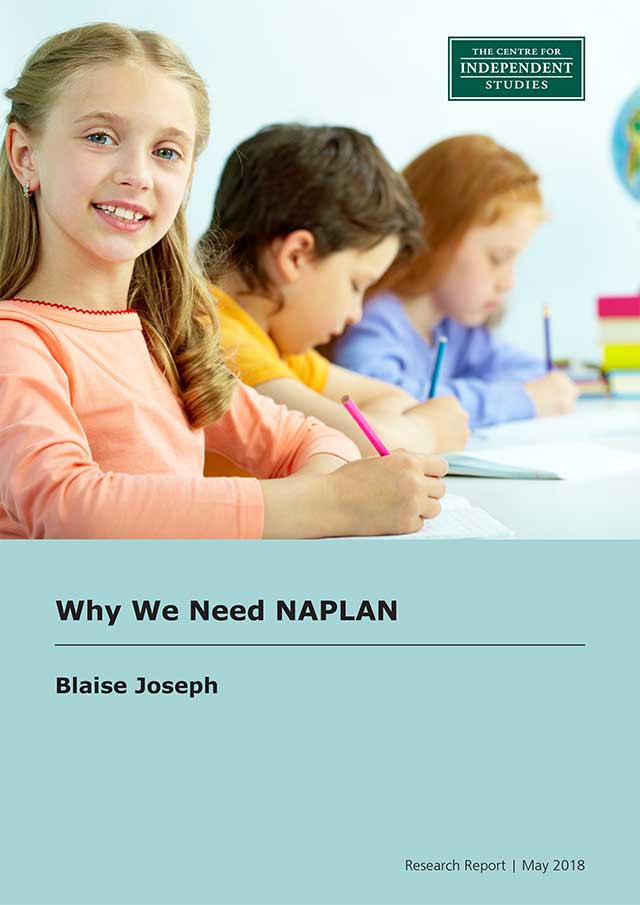
- The National Assessment Plan – Literacy and Numeracy (NAPLAN) is a crucial national assessment, but is coming under increasing criticism.
- There are three major benefits of NAPLAN:
- Tool to improve schools and teaching.
- NAPLAN results enable the identification of problems in the school system over time, and are a means for evaluating potential solutions, from the national level all the way down to individual students.
-
- Literacy and numeracy results are made transparent at a national, state and territory, and school level. Parents are also able to see how their children are progressing against an objective national benchmark.
-
- NAPLAN holds governments and schools accountable for literacy and numeracy results, which is important given the significant financial investment made in them by taxpayers and parents.
- Tool to improve schools and teaching.
- There are four common criticisms of NAPLAN, which are not supported by rigorous evidence:
- No significant improvement since NAPLAN was first introduced in 2008.
- NAPLAN results have improved significantly in some areas since 2008, and the overall trend has been positive, with the exception of writing skills.
- It is unreasonable to blame the NAPLAN tests for lack of further improvement, as NAPLAN identifies issues in the school system and does not solve them by itself.
- Nevertheless, the fact that NAPLAN results have not improved more since 2008 warrants further investigation.
- Harms students.
- The claim that NAPLAN tests harm students and causes significant student anxiety is based on surveys and small studies with serious methodological issues. A strong conclusion cannot be drawn based on the existing evidence to date.
- In general, it is not clear that testing by itself harms students. Low-level student anxiety in preparation for any test is normal, and this is very different from serious mental health issues.
- Publication of results on MySchool website harms schools.
- There have been no rigorous studies of how parents use MySchool data, and no substantial evidence to suggest MySchool has a negative effect on schools. Academic achievement is one of many factors parents use in choosing a school.
- It is far better for parents to have access to objective NAPLAN data in their decision-making, rather than having to rely solely on other factors like school reputation, school uniforms, and school websites.
- The NAPLAN tests are too narrow.
- Reading, writing, spelling, grammar, and numeracy are all necessary skills for students to succeed in later education and career paths.
- It has not been established that broader capabilities like creativity can be taught or assessed effectively.
- A focus on literacy and numeracy is appropriate given the large number of Australian children who do not have adequate skills in these areas.
- No significant improvement since NAPLAN was first introduced in 2008.
- The suggested alternative to NAPLAN of having a sample test instead would be woefully inadequate. A sample test would not have the same major benefits of NAPLAN, could not be used as a tool to help individual students, and would not promote school transparency and accountability.
- NAPLAN should be retained — because it has major benefits, and claims that it harms the school system have not been confirmed by reliable evidence — but it can be improved; and common concerns from teachers and parents should be taken into account and investigated further.
- A possible future review of NAPLAN could consider:
- how results can be better used as a tool to improve schools and teaching;
- what is preventing schools and systems from responding more effectively to NAPLAN results;
- how the purpose and benefits can be better communicated to stakeholders;
- how the administration of the tests can be improved; and
- whether or not the assessments are too narrow a measure of student ability.
- Moving NAPLAN tests online will have significant benefits; including providing more timely results to schools to facilitate earlier intervention, and allowing for computer-adjusted testing tailored to individual student ability.
Australian taxpayers invest more than $50 billion per year in the school system. NAPLAN is an important measure of the return on this investment, and provides valuable information for schools, teachers, parents, and students.
BUY HARDCOPY – SOLD OUT
Email CIS if you want to buy a printed PDF
Alternatively Download PDF here
Mail: office@cis.org.au










